Mauritius (![]() i /məˈrɪʃəs/; Mauritian Creole: Moris; French: Maurice, pronounced: [mɔˈʁis]), officially the Republic of Mauritius Hindi:मॉरीशस के गणतंत्र (Mauritian Creole: Republik Moris; French: République de Maurice) is an island nation off the southeast coast of the African continent in the southwest Indian Ocean, about 900 kilometres (560 mi) east of Madagascar. In addition to the island of Mauritius, the Republic includes the islands of Cargados Carajos, Rodrigues and the Agalega Islands. Mauritius Island is part of the Mascarene Islands, with the French island of Réunion 200 km (120 mi) to the southwest and the island of Rodrigues 570 km (350 mi) to the northeast.
i /məˈrɪʃəs/; Mauritian Creole: Moris; French: Maurice, pronounced: [mɔˈʁis]), officially the Republic of Mauritius Hindi:मॉरीशस के गणतंत्र (Mauritian Creole: Republik Moris; French: République de Maurice) is an island nation off the southeast coast of the African continent in the southwest Indian Ocean, about 900 kilometres (560 mi) east of Madagascar. In addition to the island of Mauritius, the Republic includes the islands of Cargados Carajos, Rodrigues and the Agalega Islands. Mauritius Island is part of the Mascarene Islands, with the French island of Réunion 200 km (120 mi) to the southwest and the island of Rodrigues 570 km (350 mi) to the northeast.
The British took control during the Napoleonic Wars and Mauritius became independent from the UK in 1968. Mauritius's area is 2040 km2 with Port Louis for capital. It is a parliamentary republic and is a member of the Southern African Development Community, the Common Market for Eastern and Southern Africa, the African Union, La Francophonie and the Commonwealth of Nations. Mauritius has an upper middle income economy.
The main languages spoken in Mauritius are Mauritian Creole, French and English. English is the only official language but the lingua franca is Mauritian Creole and the newspapers and television programmes are usually in French.[8] Rodriguan Creole is a minority language and is spoken in certain parts of the country only. The country is composed of several ethnicities, including Asian, African, Chinese and French. The first European explorers found no indigenous people living on the island.
The island of Mauritius is renowned for having been the only known home of the dodo. This bird was an easy prey to settlers due to its weight and inability to fly, and became extinct less than eighty years after the initial European colonization.
Contents[hide] |
[edit] History
[9] The island was known to Phonecian, Arab, and Malay sailors as early as the 10th century [10] and was originally named Revis Island by the Arabs.[11] Spanish sailors first visited it in 1507 and established a visiting base leaving the island uninhabited. Five ships of the Dutch Second Fleet were blown off course during a cyclone while on their way to the Spice Islands and landed on the island in 1598, naming it in honor of Prince Maurice of Nassau, the Stadtholder of the Netherlands.[12][13]
In 1638, the Dutch established the first permanent settlement. Because of tough climatic conditions including cyclones and the deterioration of the settlement, the Dutch abandoned the island after nearly a century in 1710.[14] France, which already controlled the neighboring Île Bourbon (now Réunion), took control of Mauritius in 1715 and later renamed it Île de France (Isle of France). Under French rule, the island developed a prosperous economy based on sugar production.
In the Napoleonic Wars (1803–1815) the British set out to gain control of the island. Despite winning the Battle of Grand Port, Napoleon's only naval victory over the British, the French surrendered to a British invasion at Cap Malheureux three months later. They formally surrendered on 3 December 1810, on terms allowing settlers to keep their land and property and to use the French language and law of France in criminal and civil matters. Under British rule, the island's name reverted to the original one. Mauritius then went on to become independent in 1968. It became a republic in 1992.
[edit] Politics

Mauritius is a vibrant democracy with a regular change of governments. The Government is elected on a five-year basis. The most recent general elections took place on May 5, 2010 in all the 20 mainland constituencies, as well as the constituency covering the island of Rodrigues. Historically, elections have tended to be a contest between two major coalitions of parties. In international affairs, Mauritius is part of the Indian Ocean Commission, the Southern African Development Community and the Commonwealth of Nations and La Francophonie (French speaking countries), amongst others. A more complete list can be found in the main Politics of Mauritius article.
In 2006, Mauritius asked to be an observing member of Community of Portuguese Language Countries (CPLP) in order to become closer to those countries.[15]
According to the 2009 Ibrahim Index of African Governance, which measures governance using a number of different variables, Mauritius' government earned the highest rank for "participation and human rights" and "sustainable economic opportunity", as well as earning the highest score in the index overall. Mauritius came second in "rule of law", and fourth in terms of "human development".[16]
| Office Held | Office Holder | Incumbency |
|---|---|---|
| President | Anerood Jugnauth | 7 October 2003 |
| Vice President | Monique Ohsan Bellepeau | 13 November 2010 |
| Prime Minister | Navin Ramgoolam | 5 July 2005 |
| Deputy Prime Minister | Rashid Beebeejaun | 7 July 2005 |
| Vice Prime Minister | Xavier Luc Duval | 7 July 2005 |
| Vice Prime Minister | Pravind Jugnauth | 11 May 2010 |
| Senior Minister | Sheila Bappoo | 7 July 2005 |
| Leader of the Opposition | Paul Raymond Berenger | 7 July 2005 |
[edit] Military and police
Mauritius does not have a standing army. All military, police, and security functions are carried out by 10,000 active-duty personnel under the command of the Commissioner of Police. This consists of an 8,000 member National Police which is responsible for domestic law enforcement, a 1,500 member Special Mobile Force (SMF), and a 500-member National Coast Guard.

[edit] Geography
Together with Réunion and Rodrigues, Mauritius is part of the Mascarene Islands. This archipelago was formed in a series of undersea volcanic eruptions 8-10 million years ago, as the African plate drifted over the Réunion hotspot. They are no longer volcanically active, and the hotspot now rests under Réunion. The island of Mauritius itself is formed around a central plateau, with its highest peak in the southwest, Piton de la Petite Rivière Noire at 828 metres (2,717 ft). Around the plateau, the original crater can still be distinguished from several mountains.
The island's capital and largest city is Port Louis, in the northwest. Other important towns are Rose-Hill and Beau-Bassin, Curepipe, Vacoas, Phoenix, Quatre Bornes.
[edit] Climate
The local climate is tropical, modified by southeast trade winds; there is a warm, dry winter from May to November and a hot, wet, and humid summer from November to May. Anti-cyclones affect the country during May to September. Cyclones affect the country during November–April. Hollanda (1994) and Dina (2002) were the worst two last cyclones to have affected the island.
[edit] Environment
The environment in Mauritius is typically tropical in the coastal regions with forests in the mountainous areas. Seasonal cyclones are destructive to the flora and fauna, however they recover quickly.
Mauritius has a Ministry of Environment that is responsible for the cleanliness of the island. One of its tasks is garbage and litter collection at public places, and it does an admirable job in the areas it services. Environmental complaints can be filed online and requests for Environmental Awareness can also be made.[17] The estuaries are becoming polluted due to garbage which is dumped into the inland ravines by the refuse companies contracted by the Ministry of Environment. This creates a huge problem with regards to toxic water flow into the various estuaries which also has a adverse effect on various marine life.[citation needed]
[edit] Districts and dependencies
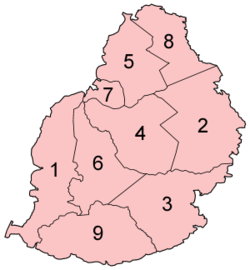 The island of Mauritius itself is divided into nine districts:
The island of Mauritius itself is divided into nine districts:
- Black River (Capital: Bambous)
- Flacq (Capital: Centre de Flacq)
- Grand Port (Capital: Mahébourg)
- Moka (Capital: Quartier Militaire)
- Pamplemousses (Capital: Triolet)
- Plaines Wilhems (Capital: Beau Bassin and Rose Hill, Phoenix)
- Port Louis (Capital of Mauritius)
- Rivière du Rempart (Capital: Mapou)
- Savanne (Capital: Souillac)
[edit] Dependencies
- Rodrigues, an island 560 kilometres (350 mi) north-east of Mauritius, which attained limited autonomy in October 2002.[18][19] It had the status of the 10th administrative district of Mauritius before autonomy was attained.[20]
- Agalega, two small islands about 933 kilometres (580 mi) north of Mauritius, famous for supplying chickens.
- Cargados Carajos, also known as the Saint Brandon islands, about 402 kilometres (250 mi) north of Mauritius.
[edit] Fishing banks within EEZ
Four submerged fishing banks are mentioned in government documents because they fall within EEZ limits:
- Soudan Banks (including East Soudan Bank)
- Nazareth Bank
- Saya de Malha Bank
- Hawkins Bank
[edit] Claimed as dependencies
Mauritius also claims the following territories:[21]
- Tromelin Island, currently in French possession.
- Chagos Archipelago, currently a British possession as the British Indian Ocean Territory (BIOT).
[edit] Economy

Since independence in 1968, Mauritius has developed from a low-income, agriculturally based economy to a middle income diversified economy with growing industrial, financial, and tourist sectors. For most of the period, annual growth has been of the order of 5% to 6%, far above the sub-Saharan African average.[22] Despite the rapid growth, that growth has been equitable and income equality has improved as its Gini coefficient fell from 45.7 to 38.9 between 1980 and 2006. This has been reflected in increased life expectancy, lowered infant mortality and improved infrastructure.[22]
Estimated at US$12,356 for 2009 at purchasing power parity (PPP),[23] Mauritius has the sixth-highest GDP per capita in Africa, behind Seychelles (US$19,274 at PPP), Equatorial Guinea (US$16,853 at PPP), Gabon (US$14,421 at PPP), Libya (US$14,381 at PPP) and Botswana (US$13,417 at PPP). The economy is mainly dependent on sugarcane plantations, tourism, textiles, and services, but other sectors such as seafood processing, information technology and medical tourism are rapidly developing as well. Mauritius, Libya, and Seychelles are the only three African nations with a "high" Human Development Index rating. Réunion, as part of France, is not listed by the UN in their Human Development Index ranking.
Sugar cane is grown on about 90% of the cultivated land area and accounts for 25% of export earnings. Mauritius is a good example of a monocrop economy but since it is no more dependent only upon agriculture, using this term would not be apt. However, a record-setting drought severely damaged the sugar crop in 1999. The government's development strategy centres on foreign investment. Mauritius has attracted more than 9,000 offshore entities, many aimed at commerce in India and South Africa, while investment in the banking sector alone has reached over $1 billion. Economic performance during the period from 2000 through 2004 combined strong economic growth with unemployment at 7.6% in December 2004. France is the country's biggest trading partner, has close ties with the country, and provides technical assistance in various forms.
In order to provide locals with access to imports at lower prices and attract more tourists going to Singapore and Dubai, Mauritius is gearing towards becoming a duty-free island within the next four years. Duty has been eliminated for several products and decreased for more than 1850 products including clothing, food, jewelry, photographic equipment, audio visual equipment and lighting equipment.[24] In addition, reforms aimed at attracting new business opportunities have also been implemented. However, one of the biggest impediments is the traffic movement between the towns, which is slowing the development of Mauritius. The corporate tax has recently been reduced to 15% to encourage non-resident companies to trade or invest through a permanent establishment or otherwise.
Mauritius ranks first among all countries in FDI inflows to India, with cumulative inflows amounting to US$10.98 billion. The top sectors attracting FDI inflows from Mauritius between January 2000 and December 2005 were electrical equipment, telecommunications, fuels, cement and gypsum products and services sector (financial and non-financial).[25]
Mauritius is one country that has achieved successful economic and human development with a dual-track approach to economic liberalisation, whereby poorer sections of society have participated in its economic growth.[26] The experience of Mauritius has been used, alongside a number of other countries that have adopted a dual-track approach, to highlight the benefits to both economic growth and human development.[26] However, inflation and its impact on living costs remains a major issue. Between 2006 and 2008, the average rate of inflation was 9.1%; between 2007 and 2010, the Consumer Price Index, which gives an idea of the cost of products that are commonly consumed, rose from a yearly average of 103.8 points to 120.2 points.
[edit] Transportation
The only available means of inland public transport, so far, are via taxi cabs and buses.[citation needed]
Transport in Mauritius has been free since July 2005 for students, the disabled and seniors. Transport has always been problematic around Port-Louis, the capital city, due to severe traffic jams. These are caused by both a lack of planning, and tolerance of hawkers or street vendors who occupy the pavements and streets of the capital.[citation needed]
The country's major airport is Sir Seewoosagur Ramgoolam International Airport, which is the main base of the national airline, Air Mauritius.
[edit] Education
Education from pre-primary through to secondary is free for each citizen born in the country, and primary level net enrolment ratio consistently above 90% (93.3% in 1991 and 94.0% in 2009).[22]
Before 2001, most prestigious schools used to be called "Star Schools" and each year, the CPE pupils would compete against each other to gain entrance to those schools based on a ranking system. In 2001, the government - with Steven Obeegadoo as minister of Education - decided that there would be an educational reform in Mauritius. The ranking system was abolished and replaced by the grading system coupled with the regionalisation system which advocates going to a school near one's residence. In February 2006, with Dharambeer Gokhool as minister of Education, the "A+" system, which is similar to the pre-2001 system, was introduced. CPE students now need to get "A+" in all their subjects to gain admission to "National Colleges" which consequently became as much coveted as the "Star Schools" were before the reform.[27]
[edit] Demographics
The population estimate for the whole republic is 1,283,415. For the island of Mauritius only, as at 31 December 2010, it is 1,245,289.[28] Mauritian society includes people from many different ethnic groups. The republic's residents are the descendants of people from India (Indo-Mauritian), continental Africa (Mauritian Creole people usually known as 'Creoles' in Mauritian Creole), France (Franco-Mauritian) and China (Sino-Mauritian), among other places.
[edit] Religion
Hindus make up 52%, Roman Catholic 27.5 %, other Christians 8.6%, Muslims 16.6% and non-religious 0.4% while other religions up to 2.5%, and an additional 0.3% didn't specify their religious beliefs.[29]
Most Franco-Mauritians and Mauritian Creoles are Christian. A small minority of the Muslim and the Hindu population are of South Asian origin. However, many Mauritians are of mixed descent; this is due to the fact that many of the slaves were mixed up causing many 'mixed races' . These languages are still preserved through the existence of different socio-cultural organizations and with the school systems obliging primary schools' students to study an oriental language. A minority of people are of Chinese descent, many of whom have embraced Christianity, following mainly Roman Catholicism. Some follow Buddhism and Confucian traditions.
[edit] Mangal Mahadev - Shiva Statue
The statue is 108 feet. It was inaugurated in 2007 and the "Sthapan" was done during the Maha Shivratri period of 2008. It is also the highest known statue in Mauritius. Now after 15 months there will be a statue of Durga Maa Bhavani of 108 feet as well next to Mangal Mahadev statue. This statue will be ready by 2011 and will be inaugurated in the same year.
[edit] Language
The Mauritian Constitution makes no mention of an official language and its one million citizens speak mostly Mauritian Creole, a French-based creole, English and French. It is only in the Parliament that the official language is English, although any member of the National Assembly can still address the chair in French.[1][30] However, English is generally accepted as the official language of Mauritius and as the language of government administration, the courts and business. The lingua franca is Mauritian Creole.[8] In Mauritius, people switch languages according to the situation.[31] French and English, which have long enjoyed greater social status, are favored in educational and professional settings.[31] Also, most newspapers, such as Le Mauricien and L'Express, and media communications are in French.[32] Mauritian Creole, which is spoken by the majority of the population, is considered to be the native language of the country and is used most often in informal settings.[31] It was developed in the 18th century by slaves who used a pidgin language to communicate with each other as well as with their French masters, who did not understand the various African languages. The pidgin evolved with later generations to become a casual language.[32] Mauritian Creole is a French-based creole due to its close ties with French pronunciation and vocabulary.[33]
Other languages spoken in certain parts of Mauritius by a limited number of people include Rodriguan Creole and Swahili. The school system of the country make it compulsory for all primary school students to study an oriental language which can be an Indian language (mostly being Hindi, Urdu, Tamil, Marathi, or Bhojpuri) or a Chinese language (either Hakka or Mandarin), Arabic or an African language such as Swahili. Most Mauritians are at least bilingual, if not trilingual.[8][32][34][35]
[edit] Culture

The cuisine of Mauritius is a blend of Indian, African, Chinese and European influences. It is common for a combination of cuisines to form part of the same meal.
The production of rum, which is made from sugar cane, is widespread on the island. Sugarcane was first introduced to Mauritius by the Dutch in 1638. The Dutch mainly cultivated sugarcane for the production of "arrack", a precursor to rum. However, it was during the French and British administrations that sugar production was fully exploited. Pierre Charles François Harel was the first to propose the concept of local distillation of rum in Mauritius, in 1850. Beer is also produced on the Island, by the Phoenix Brewery.
The sega is a local folklore music. Sega has African roots and the main traditional instruments for producing the music are goat-skin percussion instruments called ravanne, the West African Djembe and metallic clicks using metal triangles. The songs usually describe the miseries of slavery, and has been adapted nowadays as social satires to voice out inequalities as felt by the blacks. Men are usually at the instruments while women perform an accompanying dance. The origin of Sega is not completely known however it is likely to have come from West African countries such as Ghana due to the similarities in the music.[36]
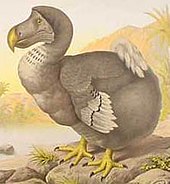
In 1847, Mauritius became the fifth location in the world to issue postage stamps. The two types of stamps issued then, known as the Mauritius "Post Office" stamps, consisting of a "Red Penny" and a "Blue Two Pence" denomination, are probably the most famous and valuable stamps in the world.[citation needed]
When it was discovered, the island of Mauritius was the home of a previously unknown species of bird, which the Portuguese named the dodo (simpleton), as they appeared to be not too bright. By 1681, all dodos had been killed by the settlers or by their domesticated animals. An alternate theory suggests that the imported wild boars that were set free destroyed the slow-breeding dodo population. The dodo is prominently featured as a supporter of the national coat-of-arms (see above).
The island has also given rise to a diversified literature in French, English and Creole. Jean-Marie Gustave Le Clézio, the 2008 recipient of the Nobel Prize in Literature, is of Franco-Mauritian origin and lives on the island for part of each year.
In Mauritius, the following festivals — Diwali, Mahashivratri, Christmas, Cavadee, Chinese New Year, Père Laval, and Eid Al-Fitr — are celebrated.[36]
Recreational activities in Mauritius are quite varied to support the local tourism industry. Water sports are facilitated as the island is surrounded with coral reef, providing plenty of relatively shallow and calm water. Activities such as deep sea fishing, surfing, windsurfing, water-skiing, cruising in yachts and even submarines are some of the many water based recreations available. Although it seldom breaks, Tamarin Bay is one of the world's most famous surfing spots. Land-based leisure activities include golf, tennis, skiing, sea diving, deer hunting, quad & mountain biking, abseiling, zip lining, horse riding and trekking.
| |||||||||||||||||||||||||||||||
| ||
| ||


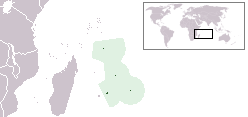




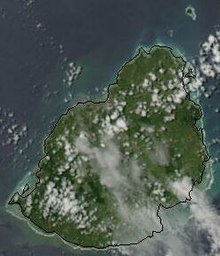












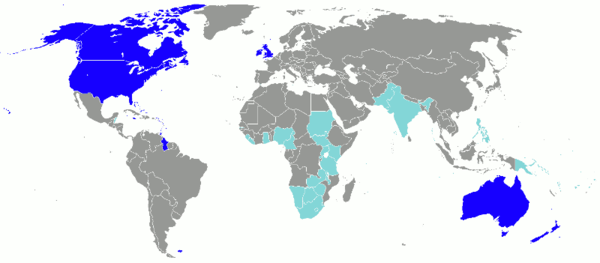
No comments:
Post a Comment